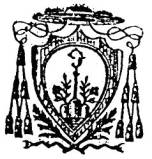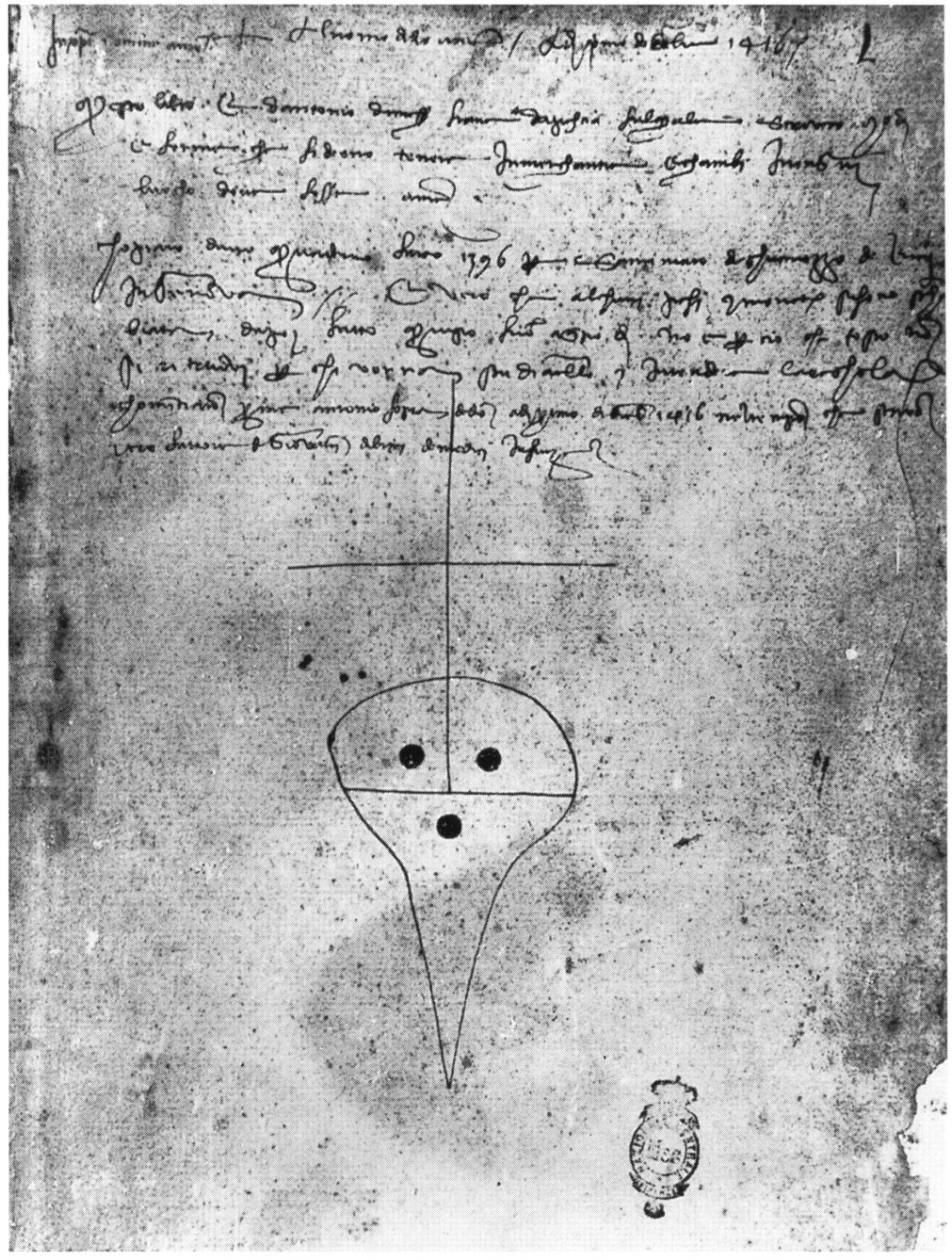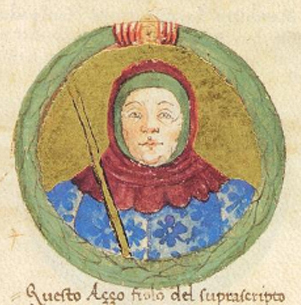|
Silvestrines
The Sylvestrines are a congregation of monks of the Order of St Benedict who form the Sylvestrine Congregation. The Sylvestrines use the post-nominal initials O.S.B. Silv.. The congregation was founded in 1231 by Sylvester Gozzolini. They are members of the Benedictine Confederation. The congregation is similar to others of eremitical origin, in that their houses are not raised to the status of an abbey, which would entangle the monasteries more strongly in the affairs of the world. The congregation, though, is led by an abbot general, the only abbot it has, who supervises all the houses of the congregation. History Sylvester Gozzolini (1177–1267) was born at Osimo near Ancona, Italy. As a young man he entered a community of Augustinian canons regular, who served Osimo Cathedral, and eventually was professed in that Order and received Holy Orders. Around 1227, he left the community to lead an austere, eremitical life. Disciples flocked to him, however, and in 1231 he built ... [...More Info...] [...Related Items...] OR: [Wikipedia] [Google] [Baidu] |
San Giorgio Alla Costa
The church of San Giorgio alla Costa, called in earlier times also ''dei Santi Giorgio e Massimiliano dello Spirito Santo'' (''of Ss. George and Maximilian of the Holy Spirit'') is a small historical church in the Oltrarno district of the centre of Florence, situated on the steep slope of via Costa San Giorgio which runs uphill from Ponte Vecchio to Forte di Belvedere. History In earlier times there existed at this locality three small churches of which one was dedicated to the martyr Saint George, another to Saint Sigismund and the third to Saint Mamilian. The church of San Giorgio (St George) predated the year 1000 and was one of the main ''priorie'' (priories) of medieval Florence. It was for this church that the young Giotto painted the altarpiece ''Madonna di San Giorgio alla Costa'' (''San Giorgio alla Costa Virgin'') known also as ''Madonna col Bambino in trono e due Angeli'' (''Virgin enthroned with Child and two angels''), currently conserved in the Diocesan Mu ... [...More Info...] [...Related Items...] OR: [Wikipedia] [Google] [Baidu] |
Fabriano
Fabriano is a town and ''comune'' of Province of Ancona, Ancona province in the Italy, Italian region of the Marche, at Above mean sea level, above sea level. It lies in the Esino valley upstream and southwest of Jesi; and east-northeast of Fossato di Vico and east of Gubbio (both in Umbria). Its location on the main highway and rail line from Umbria to the Adriatic make it a mid-sized regional center in the Apennine Mountains, Apennines. Fabriano is the headquarters of the giant appliance maker Indesit (partly owned by Whirlpool Corporation, Whirlpool). Fabriano, with Roma, Parma, Torino and Carrara, is an Italian Creative Cities Network, creative city (UNESCO). The town is in the category ''Folk Arts'' (for the Fabriano's handmade paper production). History Fabriano appears to have been founded in the early Middle Ages by the inhabitants of a small Roman town south at Attiggio (Latin ''Attidium''), of which some slight remains and inscriptions are extant. Fabriano itself wa ... [...More Info...] [...Related Items...] OR: [Wikipedia] [Google] [Baidu] |
Professed
A vow ( Lat. ''votum'', vow, promise; see vote) is a promise or oath. A vow is used as a promise, a promise solemn rather than casual. Marriage vows Marriage vows are binding promises each partner in a couple makes to the other during a wedding ceremony. Marriage customs have developed over history and keep changing as human society develops. In earlier times and in most cultures the consent of the partners has not had the importance now attached to it, at least in Western societies and in those they have influenced. Protestants, for instance, consider marriage vow as an unchangeable divine law since it needs not only "conciliar assertion" but also the support of the Scripture, making marriage a form of divine ordinance. Divine vows Within the world of monks and nuns, a vow is sometimes a transaction between a person and a deity, where the former promises to render some service or gift, or devotes something valuable to the deity's use. The vow is a kind of oath, with the deity ... [...More Info...] [...Related Items...] OR: [Wikipedia] [Google] [Baidu] |
Cosimo De' Medici
Cosimo di Giovanni de' Medici (27 September 1389 – 1 August 1464) was an Italian banker and politician who established the Medici family as effective rulers of Florence during much of the Italian Renaissance. His power derived from his wealth as a banker, and inter-marriage with other powerful and rich families. He was a patron of arts, learning and architecture. He spent over 600,000 gold florins (approx. $500 million inflation adjusted) on art and culture, including Donatello's David, the first freestanding nude male sculpture since antiquity. Despite his influence, his power was not absolute; Florence's legislative councils at times resisted his proposals throughout his life, and he was viewed as first among equals, rather than an autocrat.Martines, Lauro (2011). ''The Social World of the Florentine Humanists, 1390–1460''. University of Toronto Press. p. 8. Biography Early life and family business Cosimo de' Medici was born in Florence to Giovanni di Bicci de' Med ... [...More Info...] [...Related Items...] OR: [Wikipedia] [Google] [Baidu] |
San Marco, Florence
San Marco is a religious complex in Florence, Italy. It comprises a church and a convent. The convent, which is now the Museo Nazionale di San Marco, has three claims to fame. During the 15th century it was home to two famous Dominicans, the painter Fra Angelico and the preacher Girolamo Savonarola. Furthermore, the church houses the tomb of Pico Della Mirandola, Renaissance philosopher and so called father of humanism. History Sylvestrines The present convent occupies the site where a Sylvestrine monastery existed in the 13th century, which later passed to the Sylvestrine monks. The church was used both for monastic liturgical functions and as a parish church. From this initial period there have recently been rediscovered some traces of frescoes below floor level. In 1418 the Sylvestrines, accused of laxity in their observance of the Rule, were pressured to leave, but it took a direct intervention of Pope Eugene IV and the Council of Basel before finally in 1437 the build ... [...More Info...] [...Related Items...] OR: [Wikipedia] [Google] [Baidu] |
Tuscany
Tuscany ( ; it, Toscana ) is a Regions of Italy, region in central Italy with an area of about and a population of about 3.8 million inhabitants. The regional capital is Florence (''Firenze''). Tuscany is known for its landscapes, history, artistic legacy, and its influence on high culture. It is regarded as the birthplace of the Italian Renaissance and of the foundations of the Italian language. The prestige established by the Tuscan dialect's use in literature by Dante Alighieri, Petrarch, Giovanni Boccaccio, Niccolò Machiavelli and Francesco Guicciardini led to its subsequent elaboration as the language of culture throughout Italy. It has been home to many figures influential in the history of art and science, and contains well-known museums such as the Uffizi and the Palazzo Pitti. Tuscany is also known for its wines, including Chianti, Vino Nobile di Montepulciano, Morellino di Scansano, Brunello di Montalcino and white Vernaccia di San Gimignano. Having a strong linguisti ... [...More Info...] [...Related Items...] OR: [Wikipedia] [Google] [Baidu] |
Umbria
it, Umbro (man) it, Umbra (woman) , population_note = , population_blank1_title = , population_blank1 = , demographics_type1 = , demographics1_footnotes = , demographics1_title1 = , demographics1_info1 = , demographics1_title2 = , demographics1_info2 = , demographics1_title3 = , demographics1_info3 = , timezone1 = CET , utc_offset1 = +1 , timezone1_DST = CEST , utc_offset1_DST = +2 , postal_code_type = , postal_code = , area_code_type = ISO 3166 code , area_code = IT-55 , blank_name_sec1 = GDP (nominal) , blank_info_sec1 = €22.5 billion (2018) , blank1_name_sec1 = GDP per capita , blank1_info_sec1 = €25,400 (2018) , blank2_name_sec1 = HDI (2018) , blank2_info_sec1 = 0.884 · 12th of 21 , blank_name_sec2 = NUTS Region , blank_info_sec2 = ITE , web ... [...More Info...] [...Related Items...] OR: [Wikipedia] [Google] [Baidu] |
Rule Of St
Rule or ruling may refer to: Education * Royal University of Law and Economics (RULE), a university in Cambodia Human activity * The exercise of political or personal control by someone with authority or power * Business rule, a rule pertaining to the structure or behavior internal to a business * School rule, a rule that is part of school discipline * Sport rule, a rule that defines how a sport is played * Game rule, a rule that defines how a game is played * Moral, a rule or element of a moral code for guiding choices in human behavior * Norm (philosophy), a kind of sentence or a reason to act, feel or believe * Rule of thumb, a principle with broad application that is not intended to be strictly accurate or reliable for every situation * Unspoken rule, an assumed rule of human behavior that is not voiced or written down * Slide rule, a mechanical analog computer Science * Rule of inference or transformation rule, a term in logic for a function which takes premises a ... [...More Info...] [...Related Items...] OR: [Wikipedia] [Google] [Baidu] |
Pope Innocent IV
Pope Innocent IV ( la, Innocentius IV; – 7 December 1254), born Sinibaldo Fieschi, was head of the Catholic Church and ruler of the Papal States from 25 June 1243 to his death in 1254. Fieschi was born in Genoa and studied at the universities of Parma and Bologna. He was considered in his own day and by posterity as a fine canonist. On the strength of this reputation, he was called to the Roman Curia by Pope Honorius III. Pope Gregory IX made him a cardinal and appointed him governor of the March of Ancona in 1235. Fieschi was elected pope in 1243 and took the name Innocent IV. As pope, he inherited an ongoing dispute over lands seized by the Holy Roman Emperor, and the following year he traveled to France to escape imperial plots against him in Rome. He returned to Rome after the death in 1250 of the Emperor Frederick II. Early life Born in Genoa (although some sources say Manarola) in an unknown year, Sinibaldo was the son of Beatrice Grillo and Ugo Fieschi, Count of Lavag ... [...More Info...] [...Related Items...] OR: [Wikipedia] [Google] [Baidu] |
March Of Ancona
The March of Ancona ( or ''Anconetana'') was a frontier march centred on the city of Ancona and later Fermo then Macerata in the Middle Ages. Its name is preserved as an Italian region today, the Marche, and it corresponds to almost the entire modern region and not just the Province of Ancona. History Originally part of Imperial Italy, the march was constituted around 1100 from the March of Fermo and a southern portion of the Byzantine Pentapolis. Initially the new march took the name of its first ruler: ''marca Guarnerii'' or march of Werner. There were disputes between the Empire and the Church over rights and jurisdiction in the March. In 1173, an imperial army under Christian of Mainz invaded the March against pro-papal resistance led by Countess Boltruda Frangipani. In 1177, Pope Alexander III referred to it as "partly belonging to the empire but largely to the church". The march was definitely acquired by the Papal States during the pontificate of Innocent III in th ... [...More Info...] [...Related Items...] OR: [Wikipedia] [Google] [Baidu] |
Montefano
Montefano is a ''comune'' (municipality) in the Province of Macerata in the Italian region Marche, located about southwest of Ancona and about north of Macerata. Montefano borders the following municipalities: Appignano, Filottrano, Montecassiano, Osimo, Recanati. Sights Churches in Montefano include: * Collegiata di San Donato, Baroque style *Santa Maria Assunta * San Filippo Benizi, also in Baroque style. People * Marcello Cervini degli Spannochi, Pope Marcellus II Pope Marcellus II ( it, Marcello II; 6 May 1501 – 1 May 1555), born Marcello Cervini degli Spannocchi, was a Papalini Catholic prelate who served as head of the Catholic Church and ruler of the Papal States from 9 April 1555 until h ..., was born in Montefano. References External links Official website Cities and towns in the Marche {{Marche-geo-stub ... [...More Info...] [...Related Items...] OR: [Wikipedia] [Google] [Baidu] |





.jpg)

